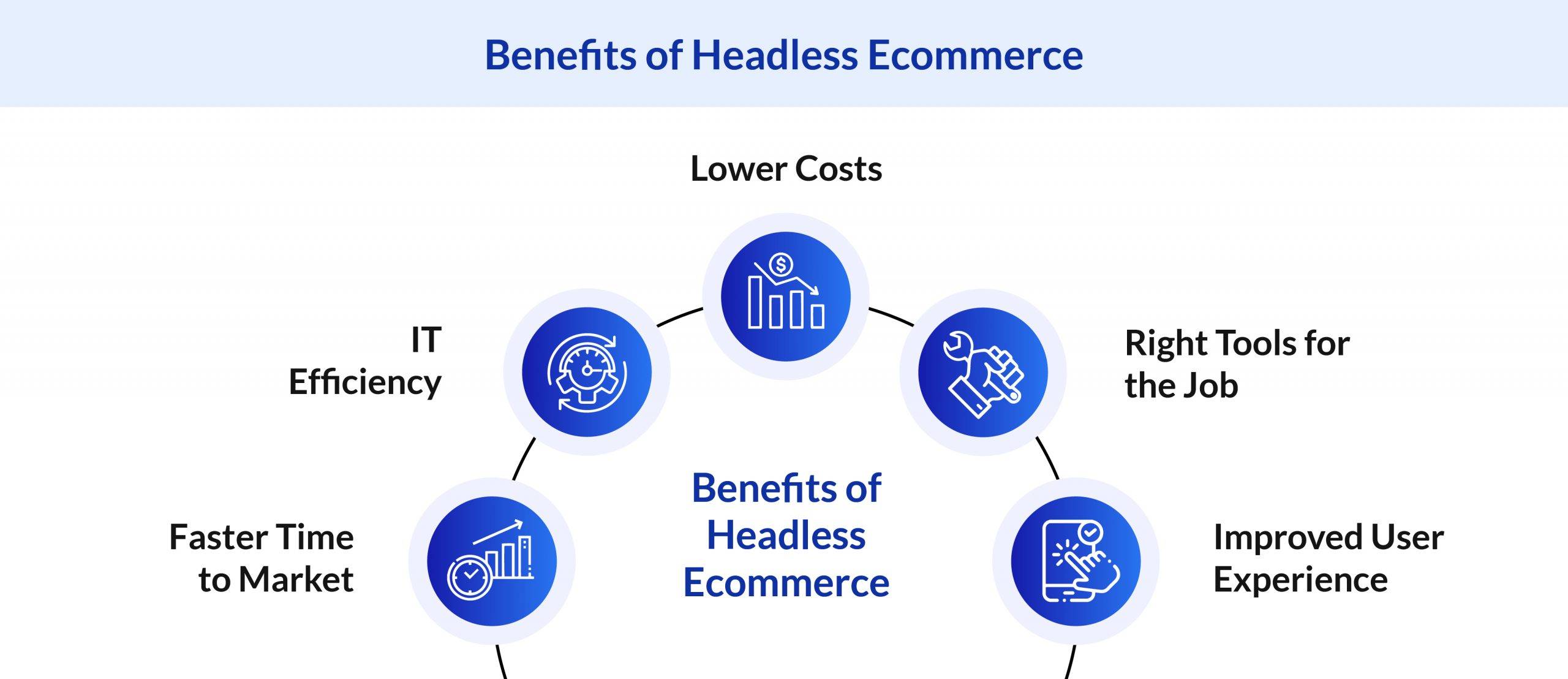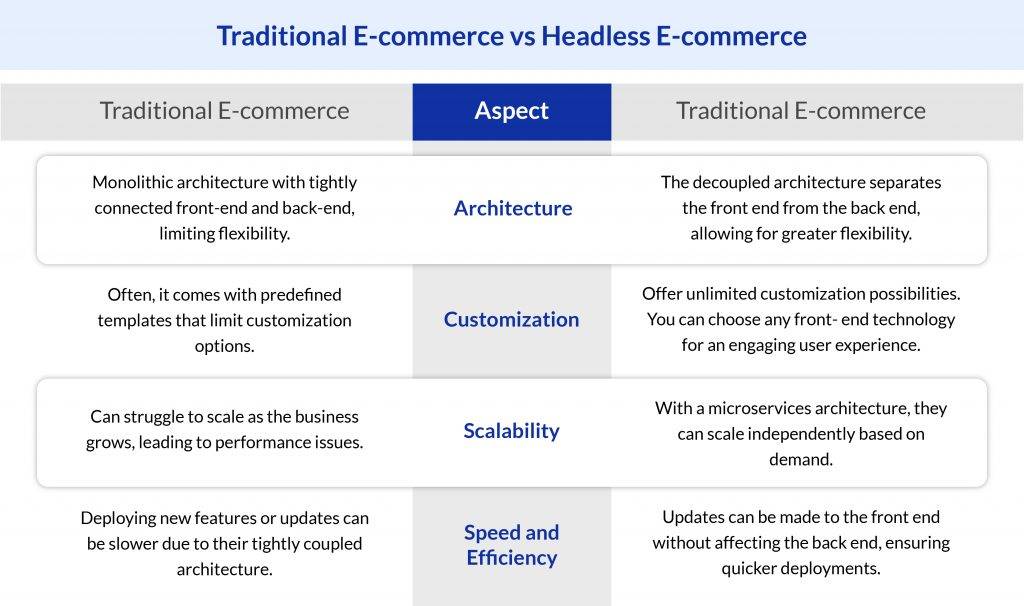Imagine being able to deliver a seamless shopping experience to your customers without the constraints of traditional e-commerce platforms holding you back. This is the potential of headless e-commerce platforms, an innovative solution that is reshaping the retail landscape.
A headless e-commerce platform is a solution that separates the back end of an e-commerce website from the front end. This decoupling gives you the flexibility to create and optimize custom experiences for different channels. It helps ensure a seamless and personalized shopping experience across all customer touchpoints.
As per a recent report by Gitnux, over 60% of major retailers across the US are likely to adopt a headless platform by 2025. This trend indicates the growing importance of headless solutions in the e-commerce industry.
This blog covers what headless e-commerce is, its technical aspects, benefits, and challenges these platforms face and how they compare to traditional e-commerce solutions.
What is Headless e-commerce?
A headless commerce platform separates the front-end presentation layer from the back-end functionality. This decoupling allows for a high degree of flexibility in content creation and delivery across various channels such as websites, mobile apps, the Internet of Things (IoT), and newer technologies like voice assistants and augmented reality.
When it comes to an e-commerce store, the frontend and backend are two key components that work together for a seamless online shopping experience. The front end refers to everything the customer interacts with while shopping online, including the website’s design, layout, fonts, colors, images, and product pages. The backend, on the other hand, includes the server, database, and applications that process orders, manage inventory, and handle customer data.
In a traditional e-commerce setup, the front-end and back-end are closely linked. This means that any changes to the user interface require major back-end modifications. However, with a headless e-commerce solution, the front-end and back-end operate independently. This enables your developers to update the front end without affecting the back end, leading to faster updates and improvements in the user interface and customer experience.
Features of a Headless E-commerce Platform
- Front End: It is the presentation layer that customers interact with. This could be a website, mobile app, or any other customer touchpoint. The front-end communicates with the back-end via the API, accessing data and business logic without any need to know how the back-end is implemented.
- Backend: It comprises the server infrastructure, databases, and web applications that manage data, process orders, and handle business logic. It ensures the smooth functioning of the e-commerce platform by supporting critical operations like content management, analytics, and reporting.
- Data Source: It refers to the repositories where product information, customer data, and other essential content are stored. Data source delivers accurate and up-to-date information to the frontend interfaces, ensuring consistency across channels.
- API (Application Programming Interface): APIs facilitate communication between the frontend interfaces and the backend systems. They enable seamless data exchange, allowing the front end to retrieve information from the backend and present it to users in a user-friendly manner.
Benefits of Headless e-commerce

Adopting a headless e-commerce approach can offer the following advantages to enhance user experience and drive your growth:
Faster Time to Market
One of the standout benefits of headless commerce is an efficient design that ensures seamless operations. Hence, it can significantly speed up the process of launching new products or campaigns. By separating the front-end and back-end, updates or changes can be made to the storefront without disrupting the back-end operations, leading to quicker deployments.
Enhancing IT Efficiency
The unlinking of the front-end and back-end in a headless e-commerce platform allows IT teams to work independently. This helps streamline the operations, as front-end developers can focus on improving the user interface, while back-end developers can concentrate on updating the inventory management system. Both teams can work separately and make the changes simultaneously, improving work efficiency.
Lower Operational Costs
Over time, the scalability and efficiency of headless e-commerce platforms can lead to lower operational costs. Each microservice, like the product catalog, shopping cart, and order management system, can be scaled independently. This eliminates the need for extensive resources required in traditional structures, making the headless approach a cost-effective solution.
Flexibility in Choosing the Best Tools
Whether it is selecting the best front-end framework for an engaging user interface or choosing the most efficient back-end technology for robust e-commerce operations, you have the freedom to pick the tools that best suit your requirements. For instance, to deliver a dynamic user interface, you can choose a modern front-end framework like React.js or Vue.js. However, to handle large volumes of customer data at the back end, you can opt for an efficient database system like PostgreSQL or MongoDB.
Improved User Experience
Seamless content delivery across multiple touchpoints ensures that customers enjoy a consistent and personalized shopping experience, whether they are shopping from a laptop, smartphone, or through a voice assistant. For example, a customer might start browsing products on a laptop during their lunch break, continue on a mobile app while commuting, and finally make a purchase through a voice assistant at home.
Challenges of Headless E-commerce
Here are potential challenges that you may face during the implementation of a headless e-commerce platform:
Technical Difficulties
Implementing a headless e-commerce functionality can present various technical challenges. These could range from integration issues when connecting the platform with existing systems to dealing with bugs that may arise due to the complex nature of decoupled systems. For example, synchronizing data between the front-end and back-end systems in real-time can be a complex task requiring advanced data management solutions.
A headless website also requires additional development effort when integrating third-party apps. Because the front end is separate, existing apps designed for traditional platforms might not work seamlessly. Custom integrations may be necessary, which can become complex if your store relies heavily on such external applications.
Higher Initial Costs
The starting cost of a headless platform can be higher than traditional e-commerce platforms. This is primarily due to the need for specialized skills and resources. For instance, you might need to hire experienced developers who are familiar with the latest front-end technologies and microservices architecture. This can quickly add to your initial investment.
Need for a Skilled Development Team
A headless e-commerce architecture requires a skilled development team that is well-equipped to handle a decoupled structure, manage microservices, and work with Application Programming Interfaces (APIs) that serve as the communication bridge between the front-end and back-end. Without such a team, companies may struggle to completely leverage the benefits of headless commerce.
Lack of Standardization
One of the major challenges of headless commerce architecture is the lack of a single and standardized technology stack. Your development team can choose from a range of frontend frameworks, including popular JavaScript libraries like React, Angular, and Vue.js, as well as specialized e-commerce options such as Vue Storefront and Shogun frontend, to build dynamic user interfaces. Currently, there is no single solution for building headless e-commerce front-ends. As a result, there is a risk of patchwork of solutions that may not work well together, leading to inefficiencies and complications in terms of system management.
Headless vs Traditional E-commerce
Here is a comparative analysis of the key differences between headless e-commerce vs traditional e-commerce:
- Architecture: Traditional e-commerce platforms typically have a monolithic architecture. In such a case, the front-end and back-end are tightly connected, limiting flexibility and features. On the other hand, a headless e-commerce platform, like Vuestorefront or BigCommerce, has a decoupled architecture that separates the front end from the back end. This allows for greater flexibility and faster updates.
- Customization: Traditional e-commerce platforms often come with predefined templates that limit customization options. In contrast, the headless architecture offers unlimited customization possibilities. You can choose any front-end technology, like Shopify or CommerceLayer, that suits your needs, leading to a personalized and engaging user experience.
- Scalability: Traditional commerce platforms can struggle to scale as the business grows, leading to performance issues. Headless e-commerce platforms, with their microservices architecture, can scale independently based on demand. This helps ensure smooth performance even during peak traffic.
- Speed and Efficiency: Deploying new features or updates can be slower on a traditional commerce architecture due to their tightly coupled architecture. With a headless commerce solution, updates can be made to the front end without affecting the back end, ensuring quicker deployments and a faster time-to-market.
- Costs: The initial costs of setting up a headless online store may be higher compared to traditional platforms due to the need for specialized skills and resources. The long-term benefits in terms of scalability, customization, and efficiency can result in significant savings over time. For instance, solutions like Saleor.io and Commerce Layer offer cost-effective options for businesses looking to embrace the headless commerce approach.

Evaluating If Headless E-commerce Is Right for Your Business
Are you managing an e-commerce brand and are uncertain about selecting the headless e-commerce model for your business? Then evaluate your needs on the factors listed here and then make an informed decision:
- If you anticipate significant growth in product offerings, traffic, or sales channels, a headless platform’s flexibility can be a major advantage. However, please ensure that your chosen platform supports your business growth and handles evolving demands effectively.
- Headless commerce thrives on APIs. Evaluate the complexity of integrating your desired functionalities (payment gateways, marketing automation tools, and others) through APIs. Solutions like BigCommerce and Commerce Layer can simplify this process.
- Do you require a headless Content Management System (CMS) to manage product descriptions, blog posts, and other website content? Some headless platforms integrate seamlessly with popular CMS solutions, while others require custom development.
- Evaluate the availability of skilled development resources and the learning curve associated with headless platforms. Solutions like Commerce.js and Nacelle can ensure a smooth implementation and easy ongoing maintenance.
The Future of e-commerce: Going Headless
As you strive to deliver seamless shopping experiences across different channels, the flexibility and scalability of headless e-commerce platforms are extremely valuable. Flipkart Commerce Cloud (FCC), with its robust infrastructure and 15+ years of experience in the e-commerce industry, is well-positioned to empower retailers in their transition towards headless commerce.
Built with Flipkart’s extensive knowledge of e-commerce and tested on billions of transactions, FCC offers robust technology solutions that can help you create personalized experiences, driving greater operational efficiencies and profitability.
FCC’s offerings include dedicated retail solutions for managing ads, pricing, and selection. These solutions, powered by Artificial Intelligence (AI) and Machine Learning (ML), enable your business to monetize your online assets, automate pricing decisions, and manage assortments to optimize merchandise sales.
Are you ready to embrace the future of online retail with a headless e-commerce platform? Get started with Flipkart Commerce Cloud today.